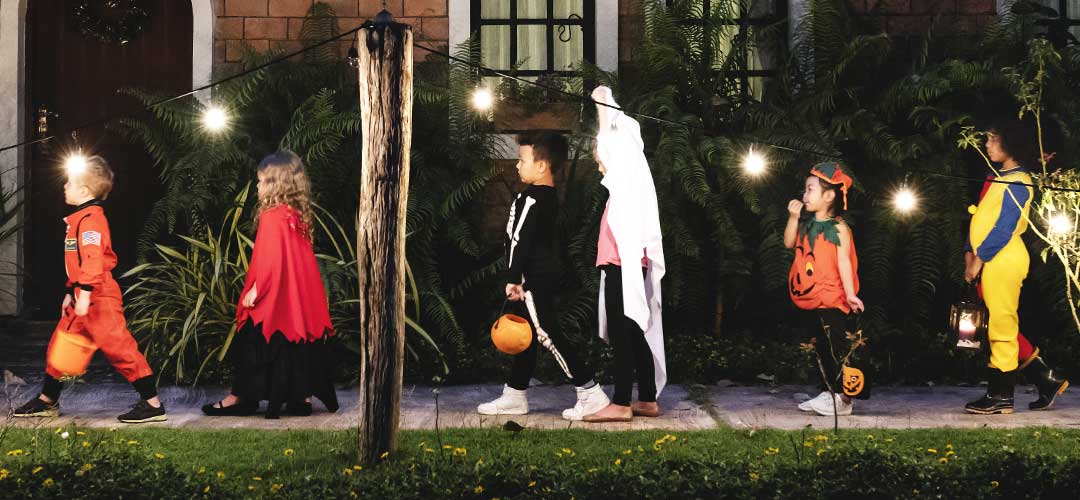
On Halloween, children and adults wander about in costumes looking for treats and a few “scares.” An injury can happen at any time or any place, but the risk is intensified by a holiday centered around wearing costumes, and walking through darkly decorated and poorly lit walkways at night while being spooked.
Under California’s Duty of Care statute, California Civil Code section 1714, property and business owners have a duty to provide a reasonably safe and secure environment for their guests. If an injury occurs because of a property owner’s failure to keep their premises in reasonably safe conditions, they may be held legally responsible for the injured person’s damages.
In the context of Halloween, CCP 1714 would require that homeowners welcoming trick-or-treaters ensure they keep the property “reasonably safe,” which depends on what a prudent property owner would have done in similar circumstances. On a basic level, the property and the walkway on it should not have unreasonably dangerous conditions or hazards to invitees. For example, there should not be any hidden traps on the ground, nor should flames be blowing out from a ghoul’s weapon. Haunted houses for Halloween are no exception to this general rule.
When it comes to haunted houses, there is an assumption of risk defense that the person entering the haunted house participated in the spooky activity and assumes the inherent risk of that particular activity.
A classic example of a haunted house premises liability case is Griffin v The Haunted Hotel, Inc. (2015) 242, Cal.App.4th 490. Plaintiff Scott Griffin and friends went to The Haunted Trail, a haunted attraction in San Diego, California. Griffin and his friends completed the trail, walked through what appeared to be the exit, and thought it was over. They were laughing about how much fun they had when an actor in costume, wielding a chainsaw, moved toward Griffin aggressively, catching him by surprise and prompting him to run away. Griffin then fell and broke his wrists. Griffin sued the operators but couldn’t find any satisfaction. A trial court ruled in favor of the defendant, with the 4th District Court of Appeal affirming the ruling. It was, the judges determined, a case of someone paying money to experience “extreme fright” and receiving “exactly what he paid for.”
However, an injured person could overcome the assumption of risk if there is proof that a hazardous or potentially dangerous condition presented an unreasonable risk of harm to a guest, that the property owner was aware of the condition, and that there was insufficient warning of that unreasonably dangerous condition.
For example, in Florida, Plaintiff, 57-year-old Cleanthi Peters, and her 10-year-old grandchild entered Hell’s High, a haunted house in Universal Studios Florida’s Halloween Horror Nights. As Ms. Peters and her grandchild were reaching the end of the trail, a Leatherface-wearing actor decided to enhance their experience by approaching them with a fake chainsaw. While being chased by “Leatherface,” they slipped on the floor near the exit door. Instead of helping the two — who slipped because of moisture from the mist used to keep the place cool — Leatherface continued to wave the chainsaw in their faces. The Court held that the “inherent risk” of entering a theme park haunted house does not involve slipping and falling due to a prop. Because of that, Universal Studios was faulted for neglecting to keep the premises safe for guests. The outcome of this matter would likely be the same in California because water on the floor in a walkway is not foreseeably related to the haunted house attraction.
TIPS TO LOWER THE RISK OF A “TRIP-OR-TREAT!”
No one wants to see or be involved in a true Halloween horror. As such, it is important to understand the potential risk and dangers associated with events included in the celebration of Halloween. We encourage first walking around the property and inspecting for potential hazards before guests of all ages come knocking on your door for Halloween. This simple walk-through could avoid a potential trip hazard that accidentally occurred before a night full of trick-or-treating.
Specifically, we recommend some common sense suggestions to lower the risks of injury or damage when celebrating:
A. Beware of dangerous decorations
Residential:
Having the best-decorated house on your block will be a small consolation after a trick-or-treater stumbles over your decorations and you face a premises liability claim for damages. Make sure that there is a clear path to get treats, all wires are covered, extension cords do not pose tripping hazards and there are no other obvious safety hazards on your property.
Commercial:
Make sure that any decorations put up in and around your business will not cause problems for customers or people passing by. Look for any possible tripping hazards and remove them. Bear in mind that kids with costumes on may have limited visibility.
B. Leave a light on
Residential:
Make sure your walkway and any stairs to the porch are well-lit. If you decorate, use Halloween-themed decorative lighting to string along the path.
Commercial:
You might want to create a creepy atmosphere but make sure that visibility inside your business is bright enough to see. You should also turn on your outdoor lighting to reduce the risk of accidents or vandalism.
Use battery-powered LED lights with proper safety certifications and avoid potentially dangerous candles in jack-o-lanterns. If you do use candles, do not leave them unattended. Be very careful to ensure that they cannot be reached by kids, and keep matches and lighters tucked away out of sight. You should also avoid using flammable decorations and costumes.
C. Don’t spook your guests (too much)
Scaring visitors might be part of your annual Halloween oeuvre but exercise caution. Jumping out from behind a pillar or decoration might scare kids enough that they fall off your porch and get seriously hurt.
D. Choose a costume for you or your child wisely:
Avoid the following:
- Flammable fabrics
- Dark costumes which are difficult to see at night
- Masks that can obstruct a child’s vision
- Costumes that do not fit properly
- Placement of buttons and other small objects on the costume which can pose a dangerous choking hazard
- Strings, ropes, and other materials that can hang from costumes, leading to strangulation and suffocation
- Dangerously Long Costumes which drag to the ground, leading to slip and fall hazards
- Dangerous chemicals and materials in clothing, leading to inhalation, lung damage, and the onset of upper respiratory diseases
- Suffocation risks from defectively designed Halloween masks.
BE CREATIVE BUT BEWARE!
Halloween is one of our most creative holidays in that it allows people to express themselves in costume and clothing, as well as make things and decorate in an interesting way. A more vigilant approach toward the celebration will help everyone have a safe and harmonious Halloween. Implementing simple precautions could be enough to prevent real blood from being part of the Halloween display. At Bradley, Gmelich + Wellerstein LLP, we wish you a spook-tacular and safe Halloween!

Jim F. Saunders, Esq. has a wide range of experience in various aspects of insurance defense litigation, including general liability, premises liability, trucking litigation, and coverage, with an emphasis on fraudulent automobile and first-party property claims. He has completed the five-day National Institute for Trial Advocacy Program and has significant jury trial experience in defending personal injury cases, having completed over 25 jury trials and participated in hundreds of arbitrations.
